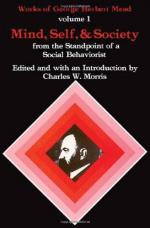|
This section contains 7,326 words (approx. 25 pages at 300 words per page) |

|
SOURCE: "George Herbert Mead's Conception of Consciousness," in Journal for the Theory of Social Behavior, Vol. 15, No. 1, March, 1985, pp. 60-75.
In the following essay, Natsoulas provides an analysis of Mead's two main concepts of consciousness and their relation to one another.
Efforts have been underway for some time to integrate into social science George Herbert Mead's contributions to our understanding of mind, self, and society. Such efforts have not yet ended for excellent reasons pertaining to the depth, richness, and repeatedly renewed relevance of Mead's theories. However, a currently relevant approach to Mead's contributions has not been exploited due to the well-known reaction early this century against mentalism. In Mead's own writings, this reaction is discussed and the methodological merits of behaviorism acknowledged. Yet, Mead's agreement with some behaviorist proscriptions did not prevent his addressing the forbidden subject matter of consciousness (e.g. Mead, 1934, p. 10). Therefore, his conception...
|
This section contains 7,326 words (approx. 25 pages at 300 words per page) |

|


